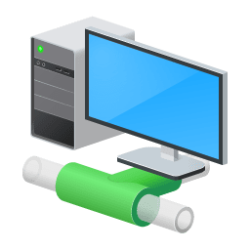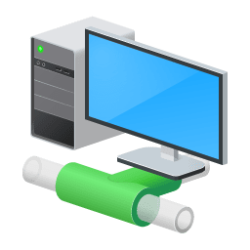In case you want to activate your Windows virtual machines, it is important that you will preserve the activation and resulted digital license. When done correctly, you can delete the virtual machine when it is no longer needed, then restore it whenever required. You can even import it to another Hyper-V host computer, preserving its activation status.
This tutorial will show you how to preserve a VM digital license in Hyper-V. Tutorial applies to Windows 8 and all later Windows versions.
Use links below to jump to any part of this tutorial, back button of your browser to return to this list.
Contents
- Part ONE: Digital licence explained
- Part TWO: Install Windows
- Part THREE: Export VM
- Part FOUR: Import VM
Part ONE
Digital license explained
1.1 Windows Digital License was introduced in Windows 10. What it means in simple terms is, that once a specific Windows edition has been activated on a physical computer or a virtual machine, next time it is online, its license status and activation will be saved on Microsoft's activation servers. All future installations of that same edition will be automatically activated. When clean installing, user can select I don't have a product key, Windows will be automatically activated based on existing digital license.
1.2 Windows Digital License is edition specific. However, it is not bit architecture or language specific. In other words, if you have installed and activated a 32-bit Windows 10 PRO in French, you can clean install a 64-bit Windows 10 PRO in Swedish on that same machine, and it will be automatically activated based on existing digital license.
1.3 Windows Digital License is based on so called hardware ID (HWID). Windows 10 has 15 different hardware IDs, none of them includes any information about internal or external storage media (HDD, SSD, VHD, DVD, USB Flash Drive and so on):
HWID
- HardwareID-0 Manufacturer + Family + Product Name + SKU Number + BIOS Vendor + BIOS Version + BIOS Major Release + BIOS Minor Release
- HardwareID-1 Manufacturer + Family + Product Name + BIOS Vendor + BIOS Version + BIOS Major Release + BIOS Minor Release
- HardwareID-2 Manufacturer + Product Name + BIOS Vendor + BIOS Version + BIOS Major Release + BIOS Minor Release
- HardwareID-3 Manufacturer + Family + Product Name + SKU Number + Baseboard Manufacturer + Baseboard Product
- HardwareID-4 Manufacturer + Family + Product Name + SKU Number
- HardwareID-5 Manufacturer + Family + Product Name
- HardwareID-6 Manufacturer + SKU Number + Baseboard Manufacturer + Baseboard Product
- HardwareID-7 Manufacturer + SKU Number
- HardwareID-8 Manufacturer + Product Name + Baseboard Manufacturer + Baseboard Product
- HardwareID-9 Manufacturer + Product Name
- HardwareID-10 Manufacturer + Family + Baseboard Manufacturer + Baseboard Product
- HardwareID-11 Manufacturer + Family
- HardwareID-12 Manufacturer + Enclosure Type
- HardwareID-13 Manufacturer + Baseboard Manufacturer + Baseboard Product
- HardwareID-14 Manufacturer
More about HWID: Specifying Hardware IDs for a Computer | Microsoft Docs
1.4 As disks are out of the equation, having nothing to do with HWID and digital license, once a computer or virtual machine has been activated with a digital license for a specific edition of Windows, you can replace the HDD, SSD, or VHD and clean re-install on a new disk, Windows being automatically activated.
This is extremely practical with virtual machines. Your VHD has grown, it's too big, or you just want to start from scratch. Simply delete the VHD, create a new one, install Windows, and it will be automatically activated.
1.5 An additional benefit is, that all Windows installations (same edition) on the PC or virtual machine have a digital license. An example: I always install first the UK English Windows PRO edition on my computers, and activate it. When activated, I will install same edition in both my native languages Finnish and Swedish, and in language of my adopted home country German on same computer in so called multi boot scenario.
I can now select any of the four language versions of Windows and boot to it, Windows being automatically activated.
Part TWO
Install Windows
2.1 Install Windows normally on a Hyper-V VM, and activate it.
2.2 My recommendation, not obligatory: Rename your VM to remind you it is activated. I simply add (activated) to VM name. For example. if the VM name is W11 PRO x64, I rename it to W11 PRO x64 (activated) as soon as I have activated it (#1 in next screenshot).
2.3 My recommendation, not obligatory: Create a checkpoint, rename it with something descriptive. I usually rename the first checkpoint as Clean install, activated (#2 in next screenshot). When necessary to start from scratch, I can simply apply this checkpoint.
Part THREE
Export VM
3.1 Shut down the VM. Select it in Hyper-V Manager, select Export on VM pane bottom right:
3.2 Click Browse to select where to export:
3.2 My recommendation is to create a folder called Hyper-V Export on an external HDD or NAS, and select it:
3.3 When you now need to free storage space on your Hyper-V host, you can simply delete the VM.
Part FOUR
ImportVM
4.1 When you again need the VM, select Import Virtual Machine on Actions pane in Hyper-V Manager (top right pane):
4.2 Click Browse, and select the folder where you exported your VM. Click Select Folder to start the import:
Please notice:
After re-installing Windows on your Hyper-V host, or renaming your Hyper-V virtual switches, you might get the following error message when importing a VM. Simply select another virtual switch from drop-down list to proceed.
4.3 IMPORTANT: In Import Virtual Machine wizard, always select Restore the virtual machine (use the existing unique ID). This will import the VM, preserving its activation status:
4.4 Selecting Register the virtual machine in-place will also preserve the activation status, but if you later delete the VM from Hyper-V Manager, it will also be deleted from your Export folder, and cannot be imported anymore.
Selecting Copy the virtual machine will create a new SID, and VM will not be activated.
That's it, geeks! Keep your activated virtual machines safe.
Kari
Last edited:













